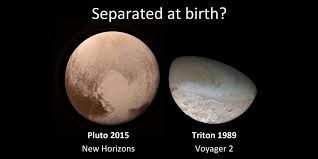Triton, Neptune’s largest moon, is a fascinating celestial body with a unique orbit and a surface covered in frozen nitrogen. It is one of the coldest places in the solar system and is thought to be a captured Kuiper Belt object.
Physical Characteristics
- Size: Triton is slightly smaller than Earth’s Moon, with a diameter of about 3,200 miles (5,150 kilometers).
- Surface: Triton’s surface is covered in a thick layer of frozen nitrogen. It is also heavily cratered, with some of the largest craters in the solar system.
- Internal Structure: Triton is believed to have a rocky core surrounded by a mantle of ice. Beneath the icy surface, there may be a subsurface ocean.
Orbit
Triton’s orbit is unusual in that it is retrograde, meaning that it orbits Neptune in the opposite direction that Neptune rotates. This suggests that Triton was captured by Neptune at a later time, rather than forming with the planet.
Geysers
Triton is known for its geysers, which erupt water vapor and ice particles into space. These geysers are thought to be caused by the heat from radioactive decay in Triton’s core.
Exploration of Triton
Triton has been visited by only one spacecraft, the Voyager 2 mission, which flew by the moon in 1989. Voyager 2 took detailed images of Triton’s surface and collected data about its atmosphere and geology.
Future Missions
There are no current plans for future missions to Triton. However, scientists are interested in exploring this fascinating moon in more detail, particularly its subsurface ocean and the possibility of life.
Triton is a unique and intriguing world that offers scientists a glimpse into the formation of the solar system. As we continue to explore this icy moon, we may discover new and exciting things about our universe.
